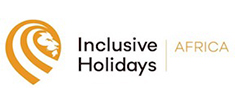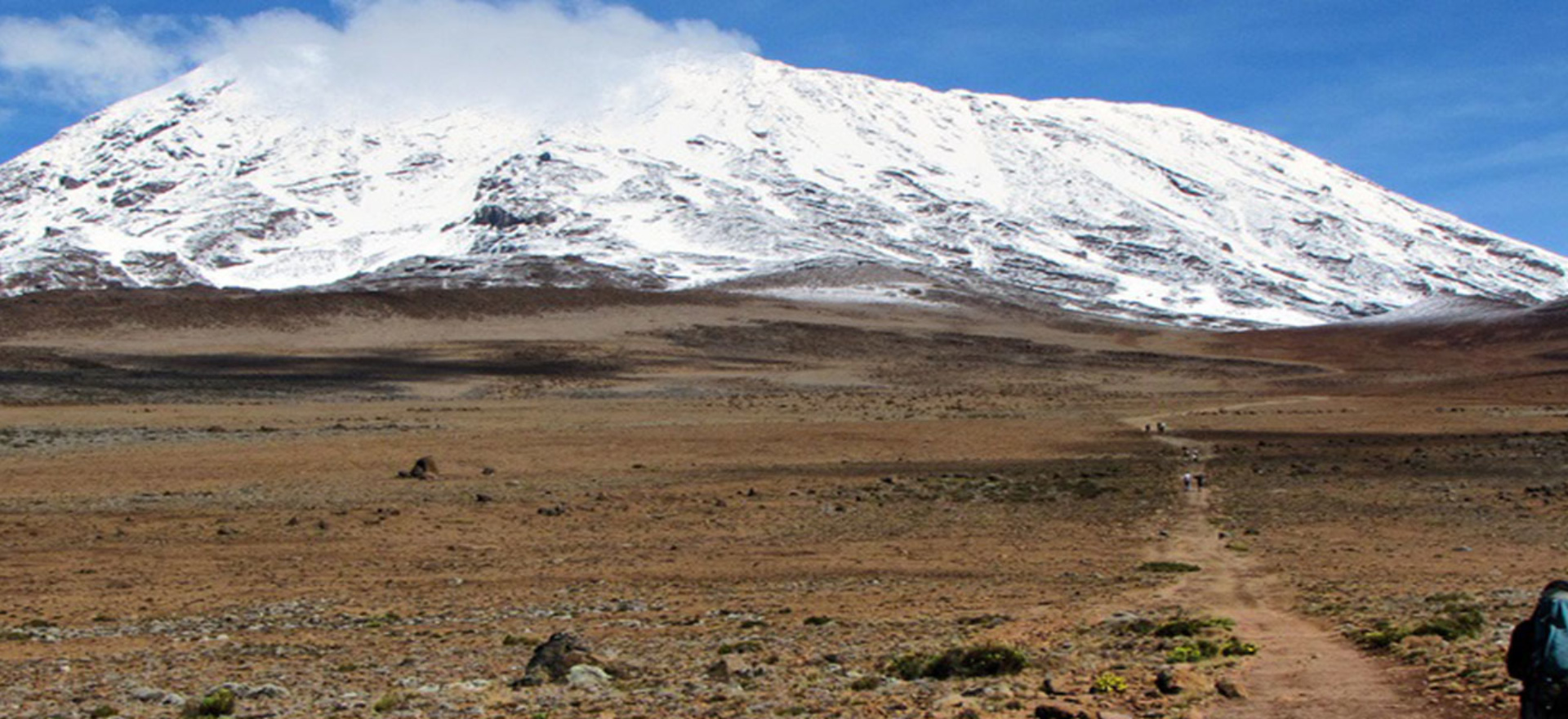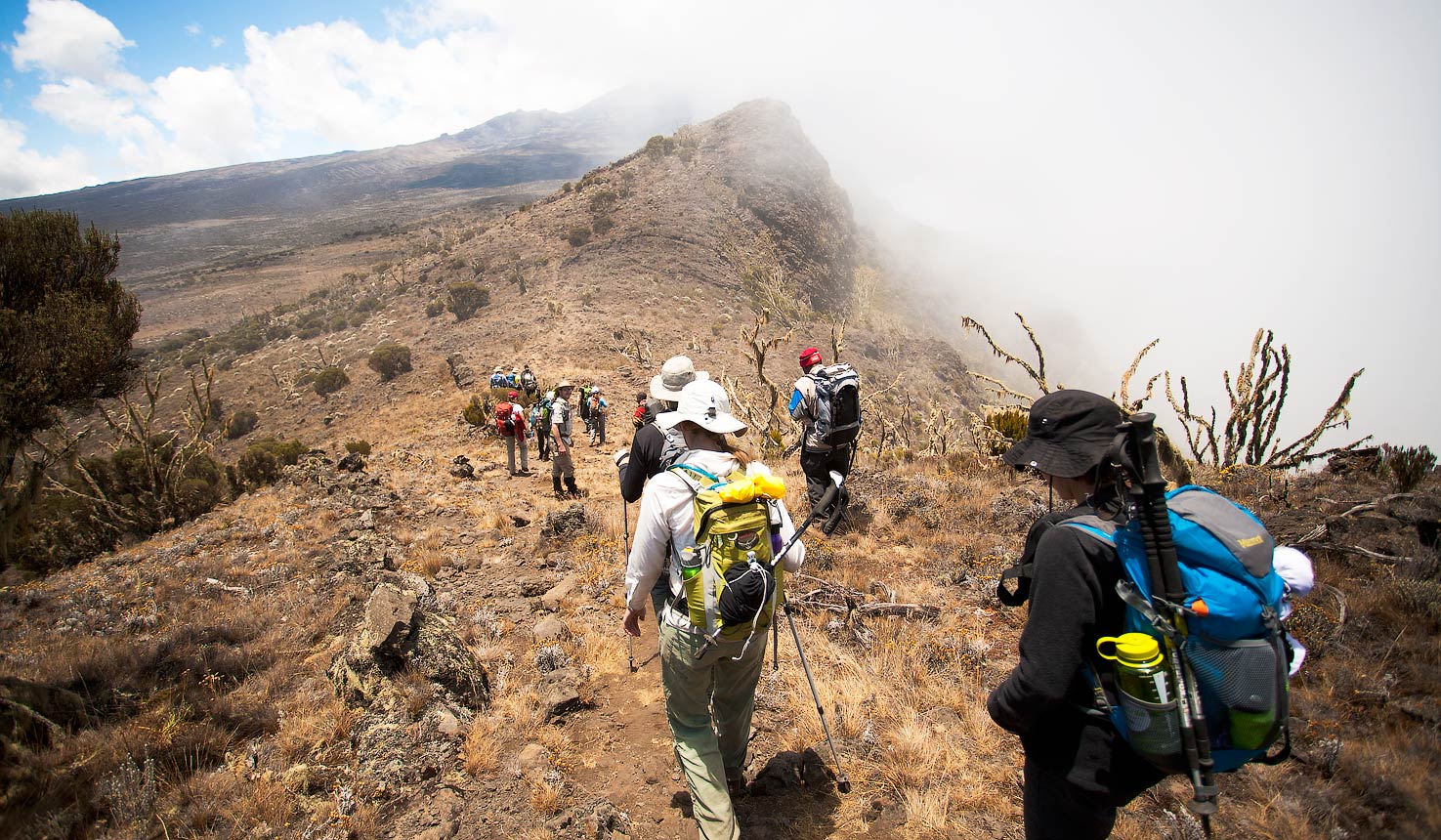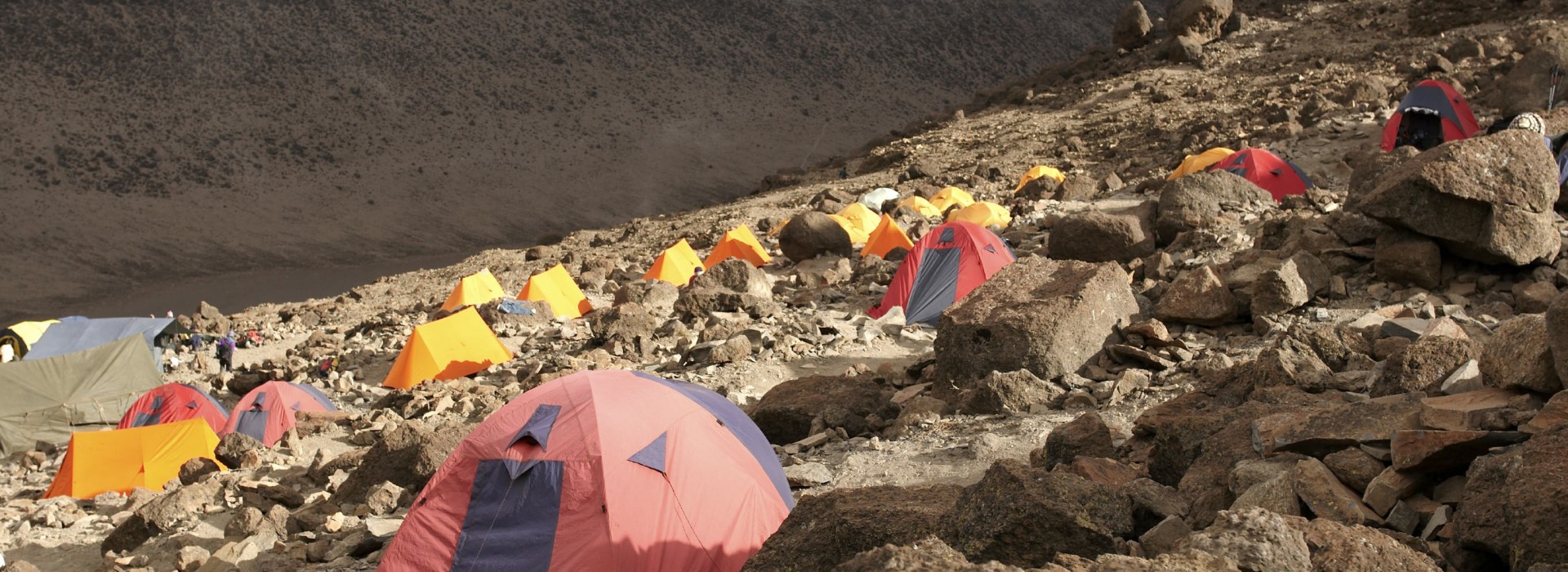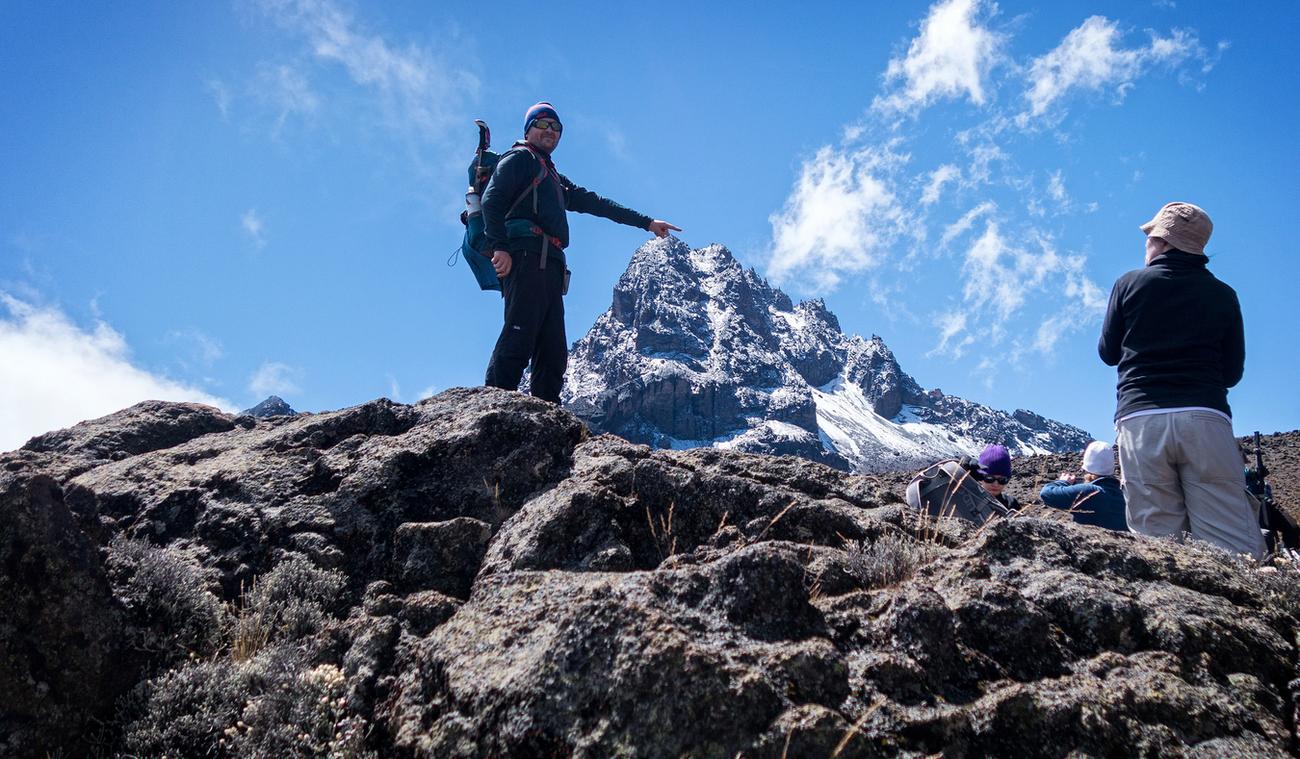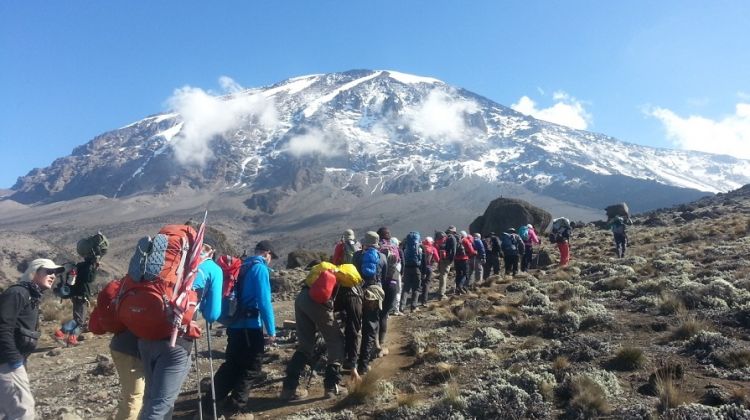Tanzania is home to the highest mountain in Africa – Mount Kilimanjaro (5895 metres), which is also the highest free-standing mountain in the world. Despite its height Kilimanjaro is one of the world’s most accessible high summits, with most climbers reaching the peak (Uhuru Peak) with little more than a walking stick, proper clothing and determination

Climbing Mount Kilimanjaro is a virtual climatic world tour, from the tropical rain forest on the lower slopes and alpine heath, to an almost bare alpine desert and finally the wintry Arctic summit of snow and ice, just 3 degrees south of the Equator.
The ascent of Kilimanjaro can be done from six routes: Mweka, Umbwe, Shira, Rongai, Machame, and the Marangu Route which is the easier one. Depending on which route one wants to take, the climb of Kilimanjaro can take between four to six nights on the mountain. The two most popular routes are Marangu and Machame. On the Marangu Route, accommodation is in alpine huts while on Machame Route it is camping throughout. While expert guides and porters will accompany you on your climb, no technical equipment is required on these routes.
ROUTES DESCRIPTION
Machame Route
This is probably the most scenic route up Kilimanjaro. The accommodation on the way up and down is strictly camping (mobile tents) only. This trek is strenuous and may be better suited to more adventurous hikers. The Machame route is normally completed in a minimum of 6 days/5nights on the mountain.
Marangu Route
The Marangu or main route is by far the most popular way to the summit. The ascent is more gradual and no professional equipment is required. The accommodation on the way up and down is provided in mountain huts with all the basic necessities. There are 60 bunk beds each (for 60 people each) at Mandara Hut (2700m) and Kibo Hut (4700m), and 120 bunk beds (for 120 people) at Horombo Hut (3720m) which is also used for descent. Climbers are supplied with mattresses and pillows, but sleeping bags should be brought along. There are communal dining halls, washrooms and toilets.
It usually takes 5 days/4nights for the round trip. The trek can also be taken in 6 days/5 nights to add acclimatization with an extra day at Horombo Hut. The supplementary cost for an extra day is indicated separately as an option.
Lemosho (Shira) Glades Route
The Lemosho Glades route is perhaps the least used initial ascent route on Kilimanjaro, partly because of its remote location and likewise the difficult roads leading to the trailhead. The road to the trailhead is only accessible by 4-wheel drive vehicles and can be impassable during wet periods. The trailhead is at relatively high elevation, and thus we start slow and easy on this route. Buffalo and elephant sightings are possible on the first day trekking through the forest, and the trail is often overgrown from lack of use.
The route is the longest distance to trek up Kilimanjaro, so fitness certainly plays a role in the enjoyment and success of this trek. The Lemosho (Shira) route takes 7 days / 6 nights on the mountain. Overall, the distance covered and the intensity of the final few days make this trek a good choice only for the experienced hiker. The many changes of scenery and spectacular hike across the Shira Plateau make this trek truly special. There are no huts on this route, the accommodation is in mountain tents
Rongai Route
There is only one route over on the north eastern side of the mountain, Rongai, which is usually a five night climb. This lesser known track may not be quite as spectacular as the western routes, but it does usually have far lower traffic than the other five night routes. This route retains a sense of unspoilt wilderness and offers a different perspective on Kilimanjaro by approaching it from the north.It is generally considered to be the easiest of the quality routes on the mountain. Rongai is the best route for people who are looking for a decent quality experience and are perhaps not absolutely confident about their fitness.
Umbwe Route
The Umbwe route, which is based in the south, is a 6-day / 5-night tour and is said to be the most scenic and difficult one offered on Kilimanjaro. The first two days are extremely steep, muddy and generally strenuous making it only suitable for well-trained mountaineers. An acclimatization day is rarely offered on the standard programme, but can be added whereby giving the climber an extra day in the Karanga Valley. The descent trail is the same as the Mweka Route.
6 DAYS MARANGU ROUTE
DAY 1: Arrive Moshi
This is the day which you should arrive into Tanzania. Most people fly into Kilimanjaro airport either directly or via Kenya. Others travel overland from Kenya. We can collect you from Kilimanjaro airport or assist you to travel from Kenya. Overnight in Keys Annexe Hotel in Moshi Town.
Briefing afternoon in Moshi Town, meet the Inclusive Holidays representative, Tanzania and have time for briefing, hiring equipment or relaxing in the hotel.
DAY 2: Trek to Mandara Hut – 2,743metres
Walk 4 hours to the Mandara Hut (2743m, 8999 ft) after registering at the gate. The slopes of Mt Kilimanjaro are classified as rainforest zone so there will likely be rain in the afternoon while travelling under the lush canopy. Enjoy the view while hiking through the lower terrain and possibly spot some of the exotic wildlife in the area. The Mandra Hut has sleeping bunks, running water and flushable toilets
DAY 3: Trek to Horombo Hut – 3,720metres
Continue up through the upper rainforest zone and reach the moorland zone at 3000m (9842 ft). In this zone plants grow to outrageous heights like the giant lobelia and giant groundsel that can reach up to 5m (16 ft). Enjoy the view of the semi-alpine zone’s plants and ravines. Reach Horombo hut (3720m, 12205 ft) and get some rest.
DAY 4: Trek to Kibo Hut – 4,703metres
Start the slow trek through the heathland and enter the alpine desert zone. Because of the increase in altitude, hike a slow pace today to allow time to get acclimatized but pay attention to any signs of altitude sickness. The ascent to the saddle of Mt Kilimanjaro is between the peaks of Kibo and Mwenzi, get a great view of Kibo after crossing the saddle. Rest for the night at Kibo Hut (4703m, 15430 ft) and prepare for the upcoming hike to the summit.
Day 5: Summit to point Uhuru – 5,895metres – Descend Horombo Hut – 3,720metres
Wake up just after midnight to start climbing to the summit. Gillman’s Point (5861m, 19229 ft) on the crater rim is easier to reach when the scree slope is frozen so the climb is best done before daylight. The view of the sunrise from the summit is also worth the early start. From Gilman’s Point, continue on to Uhuru Peak, the highest point in Africa
Take a quick moment to enjoy the view and celebrate a successful climb before starting the descent to Horombo Huts Camp. Enjoy a well-deserved rest during the last night on the mountain
Day 6: Descend to Moshi
We then descend to Marangu Gate, along an easy path back into and through the forest for 4 hours. We then transfer by road back to the hotel where a hot shower awaits! Thereafter an afternoon relaxing before you depart to the airport for your onward flight out.
8 DAYS MACHAME ROUTE
DAY 1: Arrive Moshi
This is the day which you should arrive into Tanzania. Most people fly into Kilimanjaro airport either directly or via Kenya. Others travel overland from Kenya. We can collect you from Kilimanjaro airport or assist you to travel from Kenya. Overnight in Keys Annexe Hotel in Moshi Town.
Briefing afternoon in Moshi Town, meet the Inclusive Holidays representative, Tanzania and have time for briefing, hiring equipment or relaxing in the hotel.
DAY 2: Trek to Machame Camp – 2,580metres
Transport to Machame Gate (1 hour, 1790m). Registration (sometimes it can take an hour or so before the park allows everyone to enter, they have to weigh all the porters bags first). Trek to Machame Camp through beautiful montane forest on good path. Camp overnight at the edge of the forest.
DAY 3: Trek to Shira Camp – 3,840metres
Machame Camp to Shira Plateau uphill through thinning forest and onto a huge volcanic plateau. Camping is more exposed here with great views of the summit massif.
Day 4: Trek to Barranco Camp – 3,950metres
hira Camp to Barranco Camp traversing two valleys skirting the base of the summit massif. High desert environment with amazing rock formations, quite exposed to the weather, dropping into the Barranco Valley right beneath the Western Breach. This day ascends a maximum of 700 metres but the net height gain is only about 100 metres.
Day 5: Barranco Camp – Acclimatization to 4,600metres
Barranco Camp to Karanga Valley, starting with a scramble over the Barranco Wall and over a further two valleys to get to this open campsite with great views of the Heim Glacier. Another up and down day but no net gain in height, which is all good for acclimatization.
Day 6: Trek to Barafu Camp – 4,450metres
Karanga Valley to Barafu Camp, now heading more directly upwards towards the open rock and colder temperatures. This is the average freezing level on the mountain and Barafu means ‘ice’. Camping in amongst the rocks and an early night.
Day 7: Summit to point Uhuru – 5,895metres – Descend to Millennium Camp – 2,800metres
Night-time ascent on rock and scree, occasional snow and ice, to the crater rim and the summit. Cold temperatures with windchill. Final slope to the crater rim is steeper and has loose scree. Descend in sunlight to Barafu for early lunch, and then walk to Millennium Camp, normally arriving mid-afternoon.
Day 8: Descend to Mweka Gate – 900metres
Descending through the lush forest to Mweka Gate where you sign out and pick up the summit certificate. Legs will be tired! Meet Castro at the gate for transport back to the hotel, arriving normally at about 2pm. The gate is where tips are handed out and you say goodbye to the mountain staff. A hot shower and an afternoon relaxing before you depart to the airport for your onward flight out.
8 DAYS RONGAI ROUTE
DAY 1: Arrive Moshi
This is the day which you should arrive into Tanzania. Most people fly into Kilimanjaro airport either directly or via Kenya. Others travel overland from Kenya. We can collect you from Kilimanjaro airport or assist you to travel from Kenya. Overnight in Keys Annexe Hotel in Moshi Town.
Briefing afternoon in Moshi Town, meet the Inclusive Holidays representative, Tanzania and have time for briefing, hiring equipment or relaxing in the hotel.
DAY 2: Trek to Rongai Camp – 2,800metres
We depart early in the morning and drive around Kilimanjaro to the North side where the Rongai Gate is. It takes about 3hrs but offers some great views. After registering at the gate and sorting gear for the porters we then walk through the forest for 4hrs to reach Camp 1 at 2800m. This is a great day for seeing wildlife.
DAY 3: Trek to Kikelewa Cave – 3,600metres
Today we move out on to the moorland of Kilimanjaro and have a longish day at 6hrs up to Camp 2 which is near Kikelewa Cave at 3600m.
Day 4: Trek to Mwaezi Tarn – 4,330metres
Today we are on open ground which at times can be steep as we make our way up to camp at the Mawenzi Tarn (4330m).
Day 5: Rongai Camp 3 Camp – Acclimatization
Today is a rest and acclimatization day at the tarn. You can relax at camp or go on some walks in area. This part of the mountain is beautiful and the views are stunning.
Day 6: Trek to Rongai Camp 4 Camp – 4,730metres
4hrs open ground walking today with amazing views via the Saddle to reach camp near Kibo Hut at 4730m
Day 7: Summit to point Uhuru – 5,895metres – Descend to Horombo Hut – 3,800metres
Night-time ascent on rock and scree, occasional snow and ice, to the crater rim and the summit. Cold temperatures with windchill. Final slope to the crater rim is steeper and has loose scree. Descend in sunlight to Barafu for early lunch, and then walk to Millennium Camp, normally arriving mid-afternoon.
Day 8: Descend to Marangu Gate – 900metres
We then descend to Marangu Gate, along an easy path back into and through the forest for 4 hours. We then transfer by road back to the hotel where a hot shower awaits! Thereafter an afternoon relaxing before you depart to the airport for your onward flight out.
8 DAYS LEMOSHO ROUTE
DAY 1: Arrive Moshi
This is the day which you should arrive into Tanzania. Most people fly into Kilimanjaro airport either directly or via Kenya. Others travel overland from Kenya. We can collect you from Kilimanjaro airport or assist you to travel from Kenya. Overnight in Keys Annexe Hotel in Moshi Town.
Briefing afternoon in Moshi Town, meet the Inclusive Holidays representative, Tanzania and have time for briefing, hiring equipment or relaxing in the hotel.
DAY 2: Trek to RBig Tree Camp – 2,700metres
We leave the Hotel and drive to the Londorossi Gate (2385m), which can take 3 hrs and if there has been a lot of rain the last section is on foot due to poor roads. Meet the team of porters, guides etc and upward to Big Tree Camp (2700m), 3 hours through forest
DAY 3: Trek to Shira Camp – 3,500metres
We make our way further trhough the forest then out on to open heath land reaching camp at Shira Plateau 1.
Day 4: Trek to Barranco Camp – 3,950metres
hira Camp to Barranco Camp traversing two valleys skirting the base of the summit massif. High desert environment with amazing rock formations, quite exposed to the weather, dropping into the Barranco Valley right beneath the Western Breach. This day ascends a maximum of 700 metres but the net height gain is only about 100 metres.
Day 5: Barranco Camp – Acclimatization to 4,600metres
Barranco Camp to Karanga Valley, starting with a scramble over the Barranco Wall and over a further two valleys to get to this open campsite with great views of the Heim Glacier. Another up and down day but no net gain in height, which is all good for acclimatization.
Day 6: Trek to Barafu Camp – 4,450metres
Karanga Valley to Barafu Camp, now heading more directly upwards towards the open rock and colder temperatures. This is the average freezing level on the mountain and Barafu means ‘ice’. Camping in amongst the rocks and an early night.
Day 7: Summit to point Uhuru – 5,895metres – Descend to Millennium Camp – 2,800metres
Night-time ascent on rock and scree, occasional snow and ice, to the crater rim and the summit. Cold temperatures with windchill. Final slope to the crater rim is steeper and has loose scree. Descend in sunlight to Barafu for early lunch, and then walk to Millennium Camp, normally arriving mid-afternoon.
Day 8: Descend to Mweka Gate – 900metres
Descending through the lush forest to Mweka Gate where you sign out and pick up the summit certificate. Legs will be tired! Meet Castro at the gate for transport back to the hotel, arriving normally at about 2pm. The gate is where tips are handed out and you say goodbye to the mountain staff. A hot shower and an afternoon relaxing before you depart to the airport for your onward flight out.
